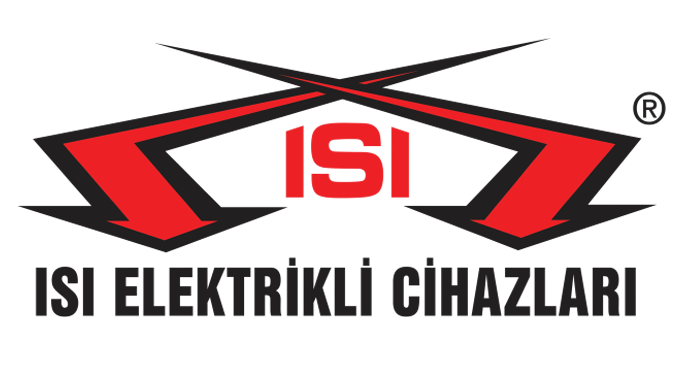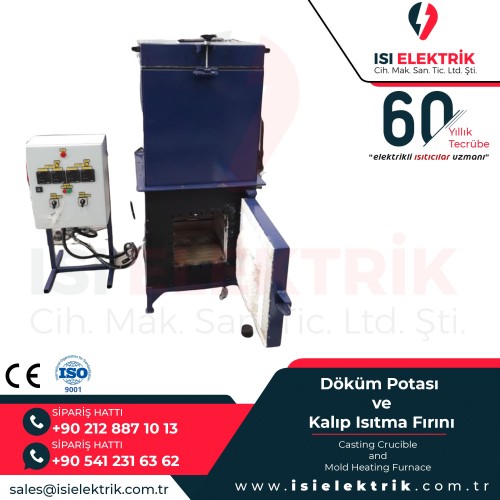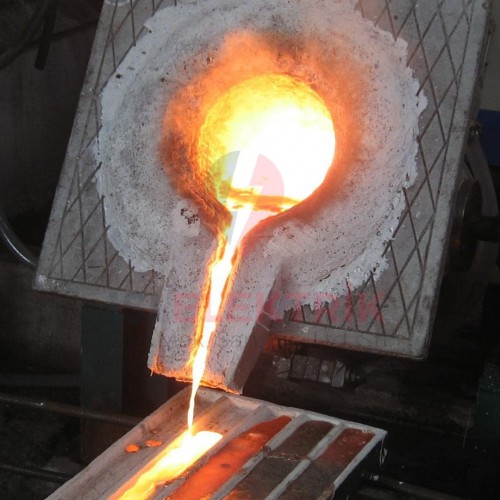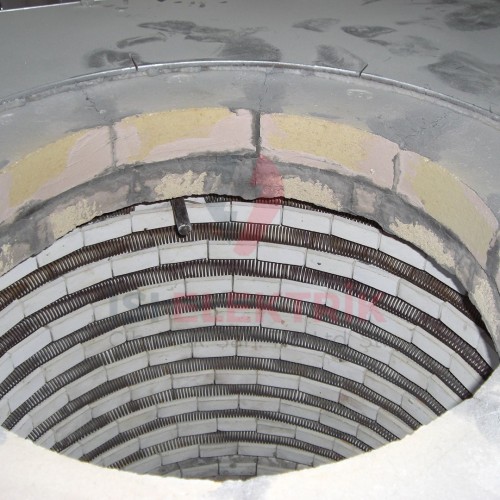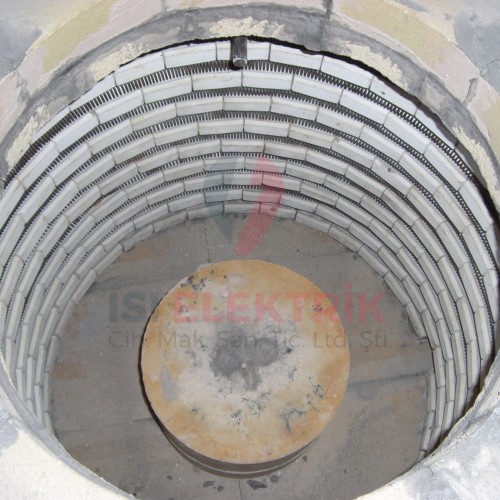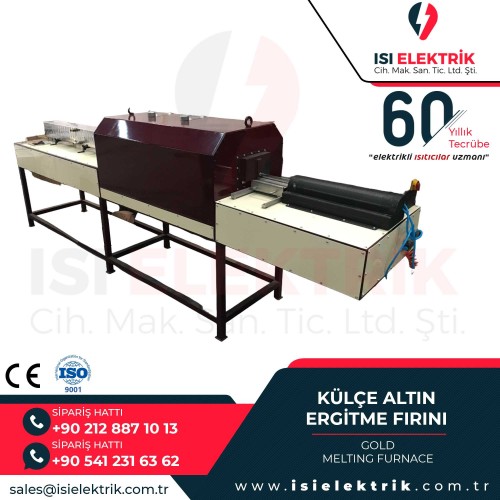Melting Furnaces
Melting furnaces are industrial equipment used for melting and casting materials. Playing a critical role in industrial production, melting furnaces are highly durable and operate at high temperatures, offering a wide range of heating methods suitable for various industries. These furnaces are indispensable in fields such as metallurgy, mining, chemical production, and construction.
Melting furnaces utilize various fuel options, including gas, oil, coal, and electricity. While electric melting furnaces have become increasingly popular due to modern technologies, fossil fuel-powered furnaces are still widely used. Electric melting furnaces provide a more environmentally friendly and energy-efficient solution, whereas fossil fuel furnaces are favored for their high capacity and lower operational costs.
These furnaces typically operate at extremely high temperatures to ensure materials reach their melting points. During the melting process, the material is heated evenly to achieve the desired properties. The melted materials are then poured, transferred into molds, or processed further in subsequent operations.
Melting furnaces are utilized in various industrial applications. For instance, in the metallurgy industry, they are used for melting and casting metals such as iron, steel, copper, aluminum, and nickel. In the mining sector, they are employed for melting and processing coal, copper, gold, and other minerals. In the chemical industry, melting furnaces are used for processing polymers, rubber, paints, and other chemical substances.
Melting furnaces are generally classified into two main types: continuous melting furnaces and submerged melting furnaces. Continuous melting furnaces are designed for the ongoing melting and processing of materials, while submerged melting furnaces handle specific batches of material for melting and casting. Depending on their design, these furnaces can be horizontal or vertical, catering to different production needs.
The technical features of melting furnaces vary depending on their intended use. For example, features such as atmosphere control, temperature control, specialized heating systems, mold systems, or casting systems determine the suitability of a furnace for processing certain materials. These features not only enhance the quality of the process but also optimize energy efficiency and workflow management.
Moreover, modern melting furnaces are equipped with digital technologies, enabling integration with automation systems. This allows for precise temperature control during operations, minimizing production errors. Additionally, energy consumption can be monitored to reduce costs and improve efficiency.
In conclusion, melting furnaces are indispensable in industrial production processes. Adaptable to various applications, these furnaces play a vital role in both small-scale and large-scale production. Combined with advanced technology, melting furnaces offer an ideal solution for enhancing efficiency and ensuring sustainability in production.
Methods of Using Melting Furnaces
The methods of using melting furnaces can vary depending on the type of furnace, the fuel used, and the intended application. However, in general, the usage process of melting furnaces involves several fundamental steps, from material preparation to post-casting operations. These processes can be adapted based on the technologies used and the type of material being processed. Here are the general methods of using melting furnaces:
-
Material preparation:
Before the melting process begins, the material to be melted is carefully selected and prepared. The material is measured by weight or volume, and these values are used to calculate the amount of heat required for the process. This step not only ensures the efficient use of energy but also guarantees the desired quality of the casting process. Additionally, impurities in the material are removed during preparation to enhance its purity.
-
Furnace preparation:
Before starting the melting process, the furnace is adjusted according to its type and the fuel being used. For instance, if an electric melting furnace is being used, the electrical system is checked to ensure proper operation. For fossil fuel-powered furnaces, the fuel system is inspected and refilled if necessary. The temperature inside the furnace is measured using thermometers or temperature control devices, and the settings are adjusted to reach the required temperature for melting the material. This process is crucial for ensuring the material melts properly and achieves the desired casting quality.
-
Material loading:
Once the preparation phase is complete, the material is carefully loaded into the furnace. During the loading process, attention must be paid to the furnace's capacity and safety measures. Overloading the furnace can negatively impact its performance or pose safety risks. The transportation equipment used in this step ensures that the material is transferred to the furnace without damage.
-
Melting and casting:
After the material is loaded into the furnace, the melting process begins. The material is heated to its melting point at high temperatures. During this process, stirring or rotating systems may be used to ensure uniform heating of the material. Once the melting point is exceeded, the material becomes liquid and is ready for casting. During the casting process, mold systems or specialized casting equipment are used to shape the material into the desired form and size.
-
Cooling:
After the casting process, the material is cooled in a controlled manner. This step is critical to ensure the material retains its properties and achieves the desired mechanical strength. The cooling techniques used may vary depending on the type of material and its intended application. For example, metals may undergo air cooling or rapid cooling in a water bath after casting.
-
Cleaning and maintenance:
Once the melting process is complete, the furnace is cleaned and prepared for the next operation. During this process, residues and leftover materials inside the furnace are removed. Additionally, the fuel system or heating equipment is inspected, and maintenance is carried out if necessary. Regular cleaning and maintenance ensure the furnace operates efficiently and has a long service life.
The methods of using melting furnaces can vary based on the type of furnace and its intended application. For instance, in continuous melting furnaces, materials are melted continuously, while in submerged melting furnaces, only specific quantities of material are melted and cast. Moreover, the methods may differ depending on the type of material being melted and its final use. For example, the methods used for melting iron and steel differ from those used for aluminum or copper.
In conclusion, the effective use of melting furnaces directly impacts the efficiency of the production process and the quality of the final product. By applying the correct methods and ensuring regular maintenance, furnaces can be used safely and for extended periods.
Melting furnaces are devices used for melting metal and other materials. Some technical specifications are listed below:- Capacity: Melting furnaces can have a certain volume and the material capacity can change according to this volume.
- Heating System: Melting furnaces can use different heating systems such as electricity, gas or oil.
- Heating Range: Melting furnaces can generally have a heating range of 1000°C to 1800°C.
- Control System: Melting furnaces can be controlled manually or automatically.
- Size and Weight: The dimensions and weight of the melting furnaces may vary according to the material capacity and melting processes.
General Information About Melting Furnaces
Melting furnaces are advanced industrial devices used for melting metals and other materials. These devices enable the processing of materials by heating them to high temperatures, making them suitable for further operations. Melting furnaces, with their varying designs, capacities, and features, are indispensable across many industrial sectors. Below is a more detailed overview of melting furnaces and their technical specifications:
-
Capacity:
The capacity of melting furnaces depends on their volume and design. Furnaces are available in different capacities, ranging from small-scale applications to large-scale industrial projects. Capacity generally refers to the amount of material a furnace can process in a single operation and is expressed in liters, kilograms, or tons. Large-scale production furnaces can handle significantly higher capacities.
-
Heating System:
Melting furnaces utilize various heating systems depending on the energy source. These include electricity, gas, oil, coal, or renewable energy sources. Electric melting furnaces are widely preferred due to their precise temperature control and environmentally friendly operation. Gas or oil-based furnaces, on the other hand, are commonly used for high-capacity applications.
-
Heating Range:
Melting furnaces generally operate within a heating range of 1000°C to 1800°C. However, this range can vary based on specific applications. For instance, lower temperatures are sufficient for melting materials like aluminum with a low melting point, whereas higher temperatures are required for steel and other refractory metals. The heating range is optimized based on the furnace design and the heating system used.
-
Control System:
Melting furnaces can be equipped with manual or automatic control systems. Modern melting furnaces typically feature digital and automated control systems, enabling precise management of temperature, timing, and energy consumption. Automation technology not only increases process efficiency but also minimizes error rates and reduces operator workload.
-
Size and Weight:
The size and weight of melting furnaces vary depending on the type of application and the furnace's capacity. Portable furnaces are suitable for small-scale operations, while fixed and larger furnaces are used in industrial facilities for continuous production. The size and weight of the furnace are also important factors when planning the installation area and considering transportation needs.
-
Additional Features:
Melting furnaces can be equipped with additional features to enhance functionality. For example:
- Atmosphere Control: Creating a specific atmosphere (e.g., an oxygen-free environment) can prevent material oxidation.
- Energy Efficiency: Furnaces with energy-saving insulation systems help reduce long-term operating costs.
- Safety Systems: Modern furnaces include fire prevention systems and emergency shutdown mechanisms due to high temperatures and energy usage.
- Modular Design: Some melting furnaces feature modular designs that can be expanded to meet specific needs.
All these technical features of melting furnaces are designed to meet different industrial requirements. A well-chosen and properly operated melting furnace can optimize production processes while enhancing energy efficiency and product quality.
How to Choose Melting Furnaces?
The selection of melting furnaces directly affects the efficiency and safety of the production process. Therefore, the following factors should be considered when choosing the right furnace:
-
Production Quantity:
Determine how much material will be processed during the melting operation. This plays a critical role in selecting the furnace capacity. Low-capacity furnaces may suffice for small-scale productions, while large industrial facilities require high-capacity models.
-
Material Type:
The type of material to be melted directly impacts the furnace design and operation. Metals like iron, steel, aluminum, and copper have different melting points, requiring furnaces with appropriate heating systems and temperature ranges.
-
Heating System:
The heating system in melting furnaces should be selected based on the energy source and production requirements. Different heating systems offer various advantages:
- Electric Systems: Environmentally friendly and suitable for precise temperature control.
- Gas Systems: Provide faster heating and energy savings.
- Liquid Fuel Systems: Offer high energy capacity and portability but require fuel storage.
-
Control System:
The control system of the furnace should be chosen based on the precision required in the production process. Automatic control systems provide a more accurate and controlled process, minimizing human error, while manual systems can be a more economical option.
-
Safety:
Safety measures are crucial for melting furnaces, as they operate at high temperatures. Features like fire prevention systems, emergency shutdown mechanisms, and thermal insulation should be prioritized.
-
Service and Support:
Technical support from the supplier for the maintenance and repair of the furnace is vital. Regular service ensures better performance and extends the furnace’s lifespan.
-
Cost and Budget:
The cost of the melting furnace should align with the budget of the facility. In addition to the purchase cost, energy consumption and maintenance expenses should also be considered.
Melting Furnaces
Melting furnaces are essential facilities in the metallurgy sector and many other industries. These furnaces are designed to melt metal ores or scrap metals into a liquid state. In these facilities, metals are heated to their specific melting points, then shaped through casting processes or further processed for the production of other products.
The primary applications of melting furnaces include:
- Metallurgy Industry: Used for melting and casting metals like iron, steel, copper, and aluminum.
- Mining Sector: Plays a critical role in melting gold, copper, and other valuable minerals.
- Chemical Industry: Utilized for processing polymers, rubber, and other chemical compounds.
- Energy Sector: Some melting furnaces are used in specialized applications within energy production processes.
There are various types of melting furnaces, classified based on their energy source and design. For example:
- Electric Melting Furnaces: An eco-friendly option providing precise temperature control.
- Gas Melting Furnaces: Offer quick and efficient heating.
- Liquid Fuel Furnaces: Suitable for high energy demands.
- Induction Furnaces: Convert electrical energy directly into heat for melting metals.
In conclusion, melting furnaces hold critical importance in the industry and are available in various types to meet diverse needs. Selecting the right furnace can significantly impact the efficiency and cost-effectiveness of production processes.
Melting Furnaces
Melting furnaces are facilities used in metallurgy, typically where metal ores or scrap metals are melted to a liquid state. In these facilities, the metal is melted at a specific temperature and then shaped through various processes or used in the production of other goods.
Resistors Used in Melting Furnaces
Resistors used in melting furnaces are made from specialized materials with properties such as high-temperature resistance, electrical resistance, and thermal stability. These resistors play a crucial role in the energy efficiency and performance of the furnaces. Below are the commonly used types of resistors in melting furnaces and their detailed explanations:
-
Kanthal Resistance Wire:
Kanthal is a special alloy composed of iron, chromium, and aluminum, known for its high-temperature resistance. This wire is highly resistant to oxidation and corrosion, ensuring durability. It can be safely used at temperatures up to 1300°C. Kanthal is widely preferred in melting furnaces due to its energy efficiency and stable performance. Additionally, its low maintenance requirements simplify production processes.
-
Nickel-Chromium Resistance Wire:
The nickel and chromium alloy stands out for its high-temperature resistance and electrical resistance properties. These resistors typically operate between 1100°C and 1200°C. In addition to melting furnaces, they are used in industrial heating systems. Nickel-chromium resistance wires provide energy savings due to their rapid heating and cooling characteristics. They also offer long-term usage with excellent mechanical durability.
-
Silicon Carbide Elements:
Silicon carbide (SiC) is a material renowned for its resistance to high temperatures and thermal shocks. It is commonly used in applications that require temperatures of up to 1600°C. These elements are frequently preferred in melting furnaces and other high-temperature furnaces due to their rapid heating capabilities and stable performance. Silicon carbide elements are ideal for industrial applications subjected to intensive use.
-
Tungsten Resistance Wire:
Tungsten is known for its high melting point (3422°C) and excellent electrical resistance properties. As a result, it is used in specialized applications requiring extreme temperatures. However, tungsten resistance wires are more expensive than other types. They are often preferred in laboratory equipment, vacuum furnaces, and special industrial projects. Tungsten resistors maintain consistent performance even during prolonged use.
In conclusion, the resistors used in melting furnaces should be selected based on the needs of the business, operating temperatures, and budget. Choosing the right resistor ensures energy efficiency and supports a safe, uninterrupted production process.
Technical Specifications of Melting Furnace Heaters
- Power: Can vary between 1 kW and 1000 kW.
- Voltage: Different voltage levels are available ranging from 12 volts to 480 volts.
- Temperature: Can withstand a wide range of temperatures from 500°C to 2000°C.
- Material: Nickel-chromium, molybdenum, tungsten, graphite, or other high-temperature resistant materials can be used.
- Diameter: Can range from 6 mm to 25 mm.
- Length: Available in different lengths ranging from 500 mm to 3000 mm.
- Connection Type: Threaded, flanged, or other types of connection methods may be available.
- Heating Element Type: Various heating element types such as wire-wound, mica band, or ceramic insulated are available.
- Cooling Method: Can be air-cooled or water-cooled.
- Protection Class: Can have a protection class of IP65 or higher.
- Mounting Type: Flanged, threaded, or other mounting types may be available.
Applications of Melting Furnace Heaters
- Plastic Industry: In plastic injection molding and extrusion processes, heaters in melting furnaces are used as heating elements. They keep plastic raw materials melted and shaped at high temperatures.
- Food Industry: Melting furnace heaters can be used in some food processing processes, especially for melting substances like sugar, chocolate, and caramel. Specially designed heaters are preferred to ensure hygienic and safe working conditions in the food industry.
- Chemical Industry: In chemical processes, melting furnace heaters can be used to melt certain substances or to provide reaction conditions. This is common in the production of various chemical products and in research laboratories.
- Electronics Industry: In the production of electronic components, especially in soldering processes, melting furnace heaters can be used. They facilitate the melting of solder materials at high temperatures and the assembly of electronic components.
Advantages of Melting Furnace Heaters
- Flexibility and Variety: Melting furnace heaters can be found in different sizes, shapes, and power levels, making them suitable for various industrial applications and customizable to the specific needs of businesses.
- Durability and Longevity: High-quality melting furnace heaters are known for their durability. When used correctly and maintained regularly, they offer a long service life.
- Controlled and Balanced Heat Distribution: Melting furnace heaters typically provide homogeneous heat distribution, ensuring uniform heating of the processed material and enabling processes to be carried out more evenly.
- Safety: Modern melting furnace heaters are often equipped with safety features such as overheat protection and overcurrent protection, ensuring the safety of operators and facilities.
- Compact Design: Melting furnace heaters generally feature a compact design, increasing flexibility in placement within the facility and saving space.
Technical Details to Consider in Melting Furnace Heater Selection
- Heat Distribution: It is important for the heater to provide homogeneous heat distribution within the melting furnaces. This ensures even heating of the processed material and achieves the desired results.
- Ease of Heater Installation: When selecting melting furnace heaters, it is important for the installation process to be easy and to avoid unnecessary complexities. Easy installation facilitates problem-solving during maintenance and service.
- Compatibility and Standards: The selected heater should comply with industry standards and safety requirements. This ensures operator safety, facility safety, and compliance with legal regulations.
- Energy Efficiency: Efficient heaters reduce energy costs and minimize environmental impact. Energy efficiency lowers operating costs in the long term and is important for sustainability.
- User-Friendly Design: Melting furnace heaters should have a user-friendly design. An easy-to-use control panel, adjustable parameters, and safety features enable operators to perform their tasks more efficiently.
Features of Melting Furnaces That Ensure High Thermal Efficiency
The high thermal efficiency of melting furnaces is essential for reducing energy consumption, lowering production costs, and minimizing environmental impact. Here are the key features that enhance the thermal efficiency of melting furnaces:
-
Quality of Insulation Materials:
High-quality refractory insulation materials used in melting furnaces minimize heat loss. These materials, known for their high-temperature resistance and low thermal conductivity, significantly improve energy efficiency.
-
Heat Recovery Systems:
Many modern melting furnaces incorporate heat recovery systems that reuse waste heat from exhaust gases. These systems substantially reduce energy consumption and increase overall efficiency.
-
Advanced Heating Technologies:
Electric resistance heaters, induction systems, and plasma heating technologies used in melting furnaces offer innovative solutions to minimize energy loss. These technologies ensure faster and more uniform heating of materials.
-
Automatic Control Systems:
Automatic control systems in modern melting furnaces allow for precise monitoring and regulation of temperatures. These systems prevent unnecessary energy consumption and maintain optimal heat conditions.
-
Modular Design:
Melting furnaces with modular designs can be optimized to meet specific needs, reducing energy consumption. Modular structures allow individual sections of the furnace to be shut down or operated independently as needed.
-
Rapid Heating and Cooling Features:
The rapid heating and cooling capabilities of melting furnaces reduce idle times and save energy. This feature also contributes to more efficient production processes.
-
Eco-Friendly Fuel Usage:
Melting furnaces that use natural gas, biofuels, or other environmentally friendly energy sources increase thermal efficiency while reducing carbon emissions.
The features listed above enable melting furnaces to operate more efficiently, sustainably, and economically. This not only reduces energy costs but also minimizes environmental impact.
Technical Details to Consider When Selecting Melting Furnaces
Making the right decision when selecting melting furnaces is crucial for production efficiency and energy savings. Below are the technical details to consider when choosing melting furnaces:
-
Production Capacity:
The selected melting furnace should match the required production capacity. An undersized furnace can disrupt processes, while an oversized one may result in energy loss.
-
Material Type:
The type of material to be melted (iron, steel, aluminum, copper, etc.) and its melting point play a decisive role. Certain furnaces may operate more efficiently with specific materials.
-
Heating System:
Among different heating systems such as electricity, natural gas, liquid fuel, or induction, the one that suits the facility’s needs should be chosen. Factors like energy cost and fuel availability should also be considered.
-
Temperature Control:
The furnace's temperature control system is critical for processing precision and energy efficiency. A precise temperature control system improves material quality.
-
Energy Efficiency:
The chosen furnace should have high energy efficiency. Insulation materials, waste heat recovery systems, and technologies that reduce energy consumption should be prioritized.
-
Durability and Material Quality:
The durability of the materials used in the furnace construction ensures long-lasting use. Refractory materials resistant to high temperatures enhance furnace performance.
-
Control and Automation:
Furnaces with automatic control systems offer higher precision and energy savings compared to manual operations. They also make production processes easier to manage.
-
Waste Management:
An appropriate waste management system should be in place for the by-products and waste gases generated during the melting process. Eco-friendly and sustainable technologies should be preferred.
-
Ease of Maintenance and Service:
The furnace should be easy to maintain, and spare parts availability and service support should be considered. A furnace that can be regularly maintained provides lower costs in the long run.
-
Cost and Budget:
The initial investment cost, operational costs, and long-term usage benefits of the melting furnace should be balanced. A cost-effective yet high-performance model should be selected.
The technical details listed above are fundamental for making the best decision when selecting melting furnaces. These criteria contribute to ensuring production processes proceed efficiently and sustainably.
Working Principle of Melting Furnaces
Melting furnaces are industrial equipment designed to reach high temperatures for melting and processing metals or other materials. The working principle of these furnaces depends on the heating system, energy source, and the type of material being processed. Generally, the working principle of melting furnaces can be summarized as follows:
1. Heating and Energy Source
Melting furnaces produce heat using one of the following energy sources:
- Electricity: Electric melting furnaces generate heat through resistance wires or induction coils.
- Gas: Fuels such as natural gas or propane provide heat via a burner system.
- Liquid Fuel: Diesel or fuel oil generates the required heat through combustion.
- Solid Fuel: Solid fuels like coal are used in more traditional melting methods.
2. Heat Transfer
The heat produced in the furnace is transferred to the material through three primary methods:
- Radiation: Heat is directly transferred to the material from furnace walls or heating elements via radiation.
- Conduction: Heat is transferred through direct contact between the material and hot surfaces.
- Convection: Heated air or gas circulates around the material, facilitating heat transfer.
3. Melting Process
Once the target temperature is reached, the material transitions from a solid to a liquid state. This process is optimized based on the melting point of the material and precise temperature control within the furnace. Uniform heat distribution ensures consistent melting.
4. Material Processing
After the melting process is complete, the molten material undergoes further processing, such as:
- Casting: The liquid material is poured into molds to take a specific shape.
- Alloy Production: Different metals are added to create specialized alloys.
- Refinement: Unwanted impurities are removed from the material.
5. Waste Management and Cooling
During the melting process, gases and other byproducts are handled in an environmentally friendly manner. Additionally, the cooling systems in melting furnaces are crucial for extending the furnace's lifespan and ensuring safe operation.
The working principle of melting furnaces is designed to enhance energy efficiency and material quality. These systems are widely used in various industries and are continually improved with technological advancements to achieve higher performance and sustainability.
Frequently Asked Questions
Melting Furnaces
